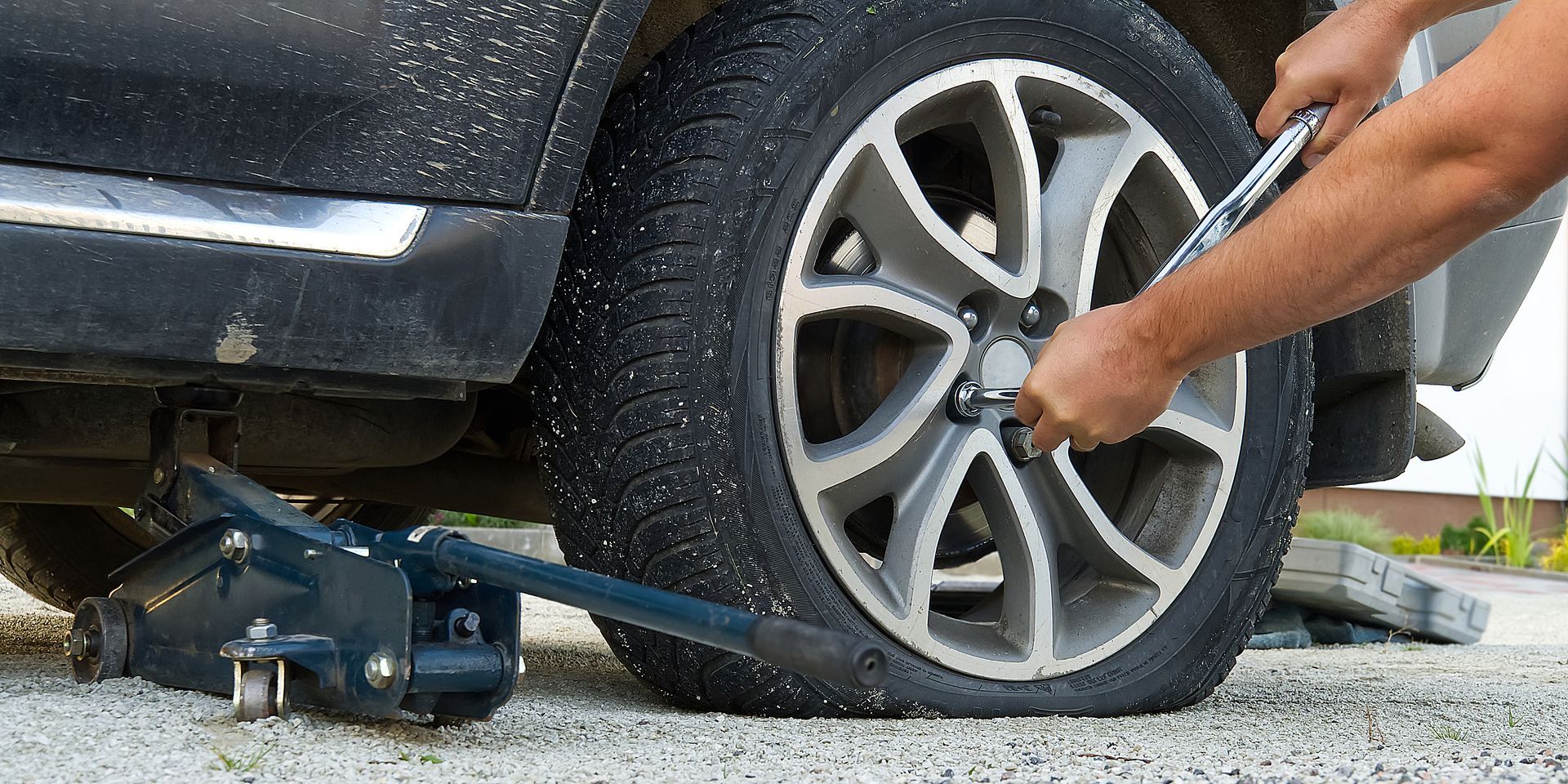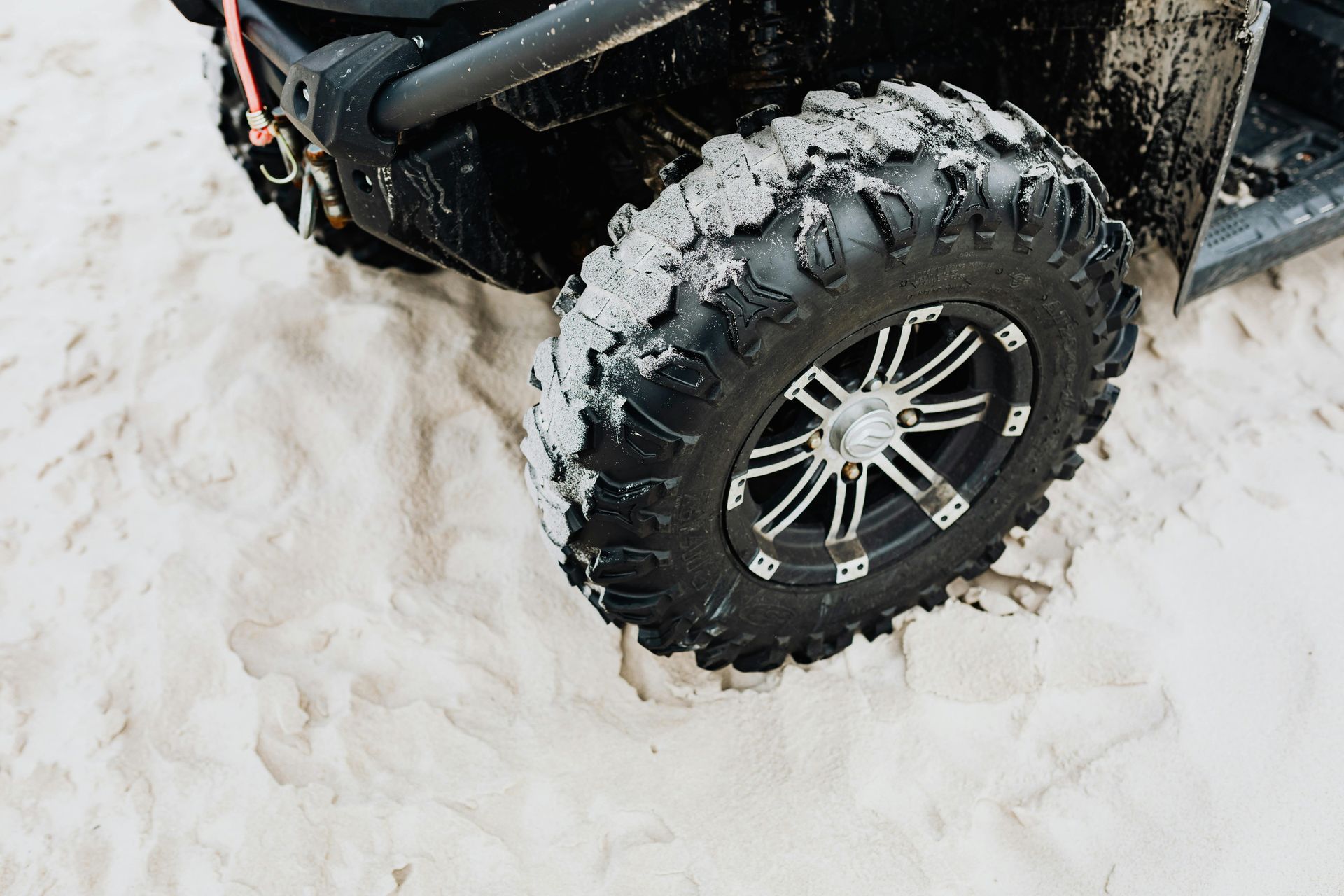If you find yourself with a flat tire while on the road, it's important to know what steps to take to safely and efficiently handle the situation. Changing a tire is a crucial skill for drivers, especially in areas with limited phone service or access to auto repair businesses. This section will provide you with a step-by-step guide on how to replace a flat tire , including the necessary tools and precautions to take. Also, keep in mind if you get a flat tire any where in the Phoenix, AZ metro area call Lug Wrench Heroes for mobile tire repair and replacement services.
Key Takeaways:
- Knowing how to change a tire is essential for every driver to handle unexpected situations.
- Keep the necessary tools such as a car jack , lug wrench , fully inflated spare tire , and vehicle owner's manual in your vehicle.
- Find a safe location, apply hazard lights, and use wheel wedges to prevent your vehicle from rolling.
- Follow the step-by-step instructions for tire replacement to ensure safety and proper installation.
- Regular tire maintenance , including tire pressure checks and inspections, is crucial to prevent flat tires.
Items Needed to Replace a Tire
To replace a flat tire , you will need certain items that should have come with your vehicle, including a car jack , a lug wrench , a fully inflated spare tire , and your vehicle owner's manual. These tools are essential for safely lifting your vehicle, removing the lug nuts, and installing the spare tire. Additionally, it is helpful to have additional items like a flashlight, rain poncho, gloves, and wheel wedges in case of emergency situations.
Having the right tools is crucial for a successful tire replacement. Here's a breakdown of the items needed:
- Car jack : A device that allows you to lift your vehicle off the ground to remove the flat tire.
- Lug wrench : A tool specifically designed to loosen and tighten the lug nuts on your vehicle's wheels.
- Fully inflated spare tire: A properly inflated tire that can be used temporarily until you can get the flat tire repaired or replaced.
- Vehicle owner's manual: This manual provides specific instructions and guidance for your particular vehicle model.
While these tools are essential, it's also important to be prepared for various situations. Consider having a flashlight to illuminate the area, a rain poncho to protect yourself in inclement weather, gloves for a better grip, and wheel wedges to prevent your vehicle from rolling while you're replacing the tire.
Instructions for Replacing a Tire
Step 1: Find a Safe Location
When you have a flat tire, the first step is to find a safe location to stop your car. Look for a level and solid ground away from oncoming traffic. This will ensure your safety while you work on replacing the tire. Remember to turn on your hazard lights and apply the parking brake to further alert other drivers.
Step 2: Use Wheel Wedges and Remove the Hubcap
Before you start changing the tire, it's important to use wheel wedges to prevent your vehicle from rolling. Place them on the opposite side of the flat tire, both in front and behind the tire. Once the wedges are in place, you can proceed to remove the hubcap. You can use a flathead screwdriver or a lug wrench to pry it off gently.
Step 3: Loosen the Lug Nuts and Position the Car Jack
Next, loosen the lug nuts on the flat tire. You can use a lug wrench for this step. Once the lug nuts are loosened, position the car jack under your vehicle according to your owner's manual instructions. It's crucial to place the jack in the correct location to ensure stability and safety while lifting the vehicle.
Step 4: Raise the Vehicle and Remove the Flat Tire
With the car jack in place, start raising the vehicle until the flat tire is completely off the ground. Once the tire is lifted, you can now remove the lug nuts and carefully take off the flat tire. Place the flat tire aside and avoid placing it directly on the ground to prevent any damage.
Step 5: Mount the Spare Tire and Lower the Vehicle
Now it's time to mount the spare tire onto the vehicle. Align the spare tire with the lug bolts and push it gently onto the wheel hub. Once the spare tire is properly mounted, hand tighten the lug nuts. Lower the vehicle slowly using the car jack until the spare tire touches the ground.
Step 6: Tighten the Lug Nuts and Perform Final Checks
To secure the spare tire in place, use the lug wrench to tighten the lug nuts. Start by tightening them in a star pattern to ensure even tightening. Once the lug nuts are secure, lower the vehicle completely and remove the car jack. Finally, check the tire pressure of the spare tire and make sure it matches the recommended pressure in your vehicle owner's manual.
Congratulations! You have successfully replaced your flat tire with a spare tire. Remember to take your flat tire to a professional tire repair shop for proper inspection and repair as soon as possible.
Take Preventative Measures
When it comes to flat tires, prevention is key. By taking proactive measures to maintain your tires, you can significantly reduce the risk of experiencing a flat tire on the road. Regular tire maintenance is essential for the longevity and performance of your tires. Here are some important preventative measures to keep in mind:
1. Tire Pressure Check
One of the most crucial aspects of tire maintenance is regularly checking the tire pressure. Properly inflated tires not only improve fuel efficiency but also enhance traction and handling. Use a tire pressure gauge to measure the air pressure in each tire, including the spare tire. Refer to your vehicle owner's manual for the recommended tire pressure, as it may vary depending on the make and model of your car. If the pressure is too low, inflate the tire to the correct level. Conversely, if the pressure is too high, release some air until it reaches the appropriate range.
2. Tire Rotation
Tire rotation is another important preventative measure to extend the life of your tires. Regularly rotating your tires helps distribute the wear and tear evenly across all tires, resulting in more balanced performance and longer tread life. Consult your vehicle owner's manual for the recommended tire rotation pattern and frequency. Typically, tire rotation is recommended every 5,000 to 8,000 miles, or as specified by the manufacturer.
3. Tire Inspection
Regularly inspecting your tires for signs of damage or wear can help identify potential issues before they escalate into major problems. Look for any visible cuts, bulges, or punctures on the tire surface. Check the tread depth using a tread depth gauge or the penny test. If the tread depth falls below 2/32 of an inch, it's time to replace the tire. Additionally, pay attention to any vibrations or unusual noises while driving, as these may indicate tire issues that require immediate attention.
| Tire Maintenance Tip | Recommended Frequency |
|---|---|
| Tire Pressure Check | Once a month |
| Tire Rotation | Every 5,000 to 8,000 miles |
| Tire Inspection | Once a month |
By following these preventative measures, you can minimize the likelihood of encountering a flat tire and ensure your tires are in optimal condition for safe and smooth driving.
Key Statistics about Flat Tires
Understanding the key statistics about flat tires can provide valuable insights into the prevalence and impact of this issue. By gaining a deeper understanding of these statistics, you can better appreciate the importance of addressing flat tires and taking appropriate measures to prevent them.
Tire-Related Fatalities
In the United States alone, tire-related crashes resulted in 664 traffic fatalities in 2020. These tragic incidents highlight the serious consequences that can arise from a flat tire and the need to address them promptly and effectively. Taking the necessary precautions and regularly maintaining your tires can significantly reduce the risk of facing such unfortunate outcomes.
Run-Flat Tires
Only about 15% of new vehicles are equipped with run-flat tires. These specialized tires are designed to allow limited driving on a flat tire, providing a temporary solution until the tire can be repaired or replaced. While run-flat tires offer some advantages in terms of convenience and safety, they are not a foolproof solution, and it's important to understand their limitations and take appropriate actions when faced with a flat tire.
Tire Punctures
Approximately 220 million flat tires occur each year in the United States, with one tire puncture happening every seven seconds. These statistics highlight the frequency at which flat tires occur and the need for drivers to be prepared to deal with this issue. Regular tire maintenance, including proper inflation and regular inspections, can help identify potential issues and reduce the likelihood of experiencing a tire puncture while on the road.
Conclusion
Dealing with a flat tire can be stressful, but it is important to remember that your safety should always be your top priority. By following the proper steps and taking preventative measures, you can handle this situation with confidence.
When faced with a flat tire, finding a safe location to stop and applying the necessary tools are crucial. Make sure to use proper techniques for changing a tire, such as loosening the lug nuts before raising the vehicle with a jack. Taking these precautions will help ensure your safety and the effectiveness of the tire replacement process.
Regular tire maintenance is also key to reducing the risk of experiencing a flat tire. Checking tire pressure, rotating the tires according to the manufacturer's guidelines, and inspecting the tire treads regularly are all important practices to adopt. By doing so, you can ensure that your tires are in good condition and minimize the chances of encountering a flat tire in the first place.
Remember, knowing how to handle a flat tire is an essential skill for all drivers. By familiarizing yourself with the process and staying prepared for any unexpected tire issues, you can confidently handle this situation and keep yourself safe on the road.
FAQ
What should I do if I have a flat tire?
If you have a flat tire, it's important to find a safe location to stop, turn on your hazard lights, apply the parking brake, and use wheel wedges to prevent your vehicle from rolling. Follow the step-by-step instructions provided in this guide to safely replace the flat tire.
What items do I need to replace a tire?
To replace a tire, you will need a car jack, a lug wrench, a fully inflated spare tire, and your vehicle owner's manual. Additional items like a flashlight, rain poncho, gloves, and wheel wedges can also be helpful in case of emergency situations.
How do I replace a tire?
Start by finding a safe location to stop your car. Turn on your hazard lights and apply the parking brake. Use wheel wedges to prevent your vehicle from rolling. Follow the step-by-step instructions provided in this guide to safely replace the tire.
What preventative measures can I take to avoid flat tires?
Regular tire maintenance is crucial to avoid flat tires. This includes proper tire inflation, regular tire rotations according to the manufacturer's guidelines, and conducting regular inspections for wear and tear on the tire treads. By maintaining your tires properly, you can improve their performance, extend their lifespan, and reduce the chances of experiencing a flat tire.
What are some key statistics about flat tires?
In the United States, tire-related crashes resulted in 664 traffic fatalities in 2020. Only about 15% of new vehicles are equipped with run-flat tires. Approximately 220 million flat tires occur each year in the United States, with one tire puncture happening every seven seconds. It's important to note that not all vehicles come with a spare tire as a standard feature.
Why is it important to know how to handle a flat tire?
Knowing how to handle a flat tire is important because it can help you safely and efficiently handle the situation when you are on the road. By following the proper steps and taking preventative measures, you can handle this situation with confidence and reduce the risk of flat tires.














